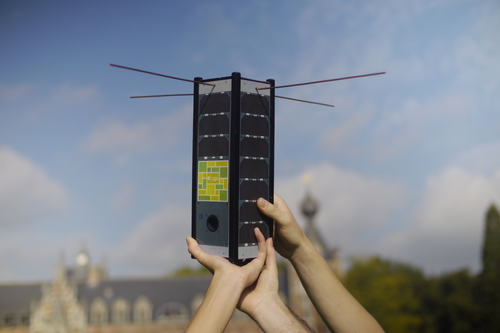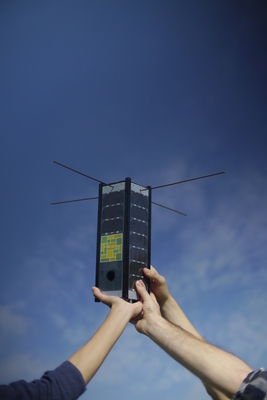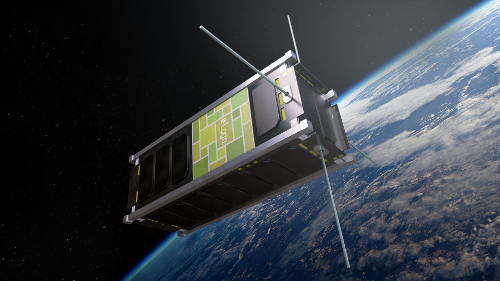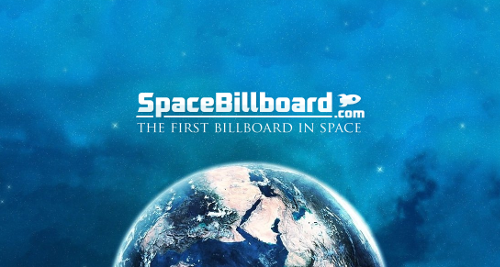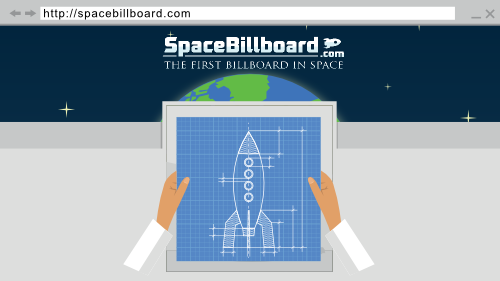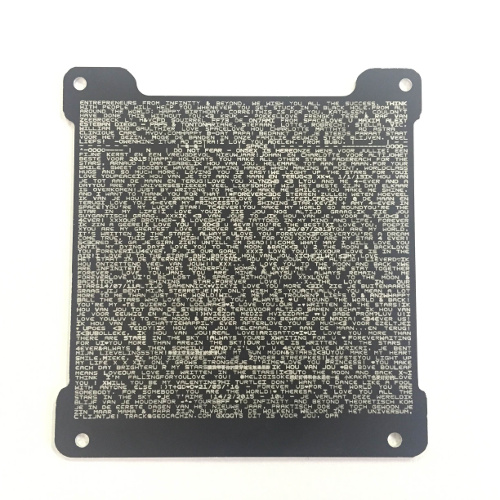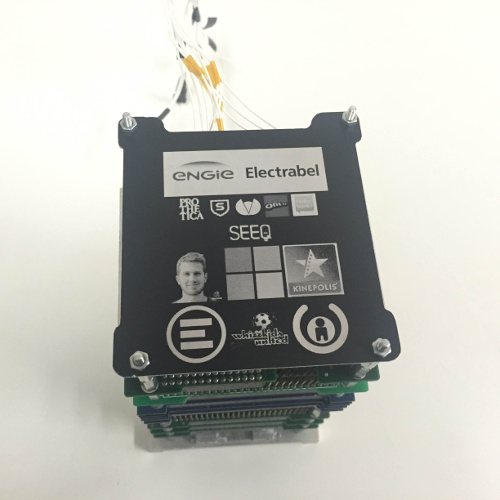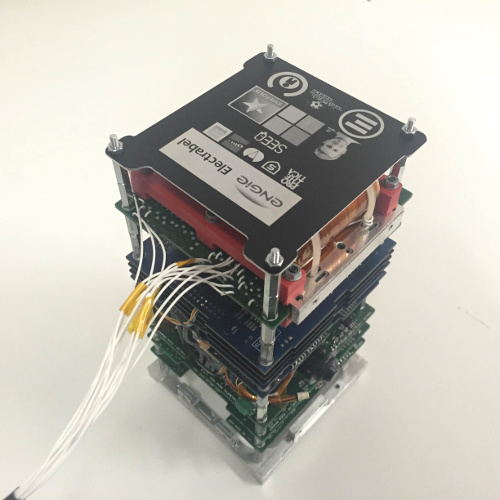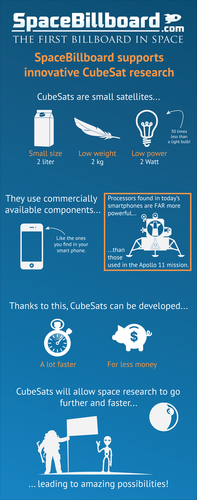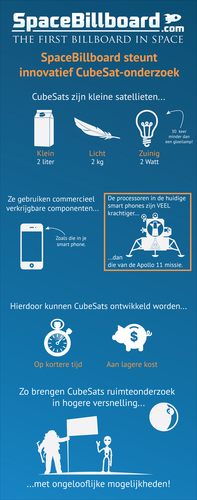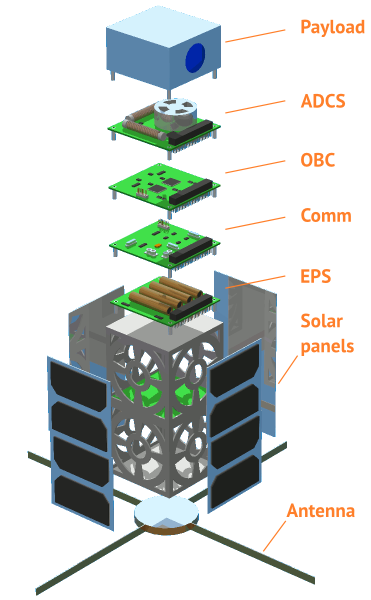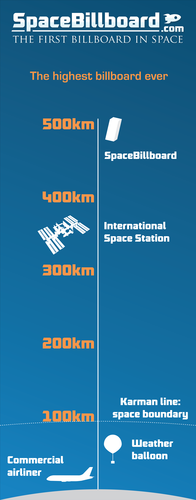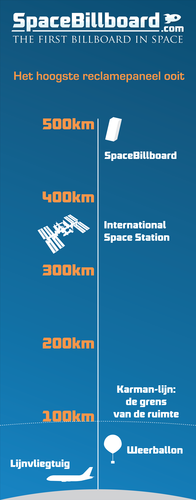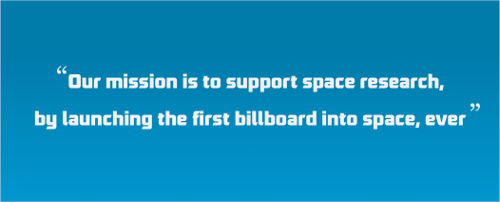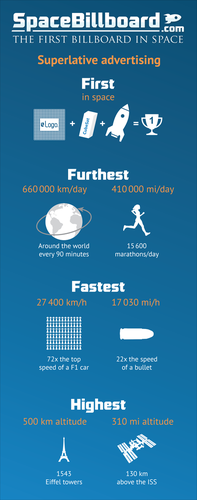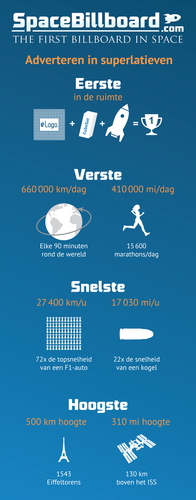For press
Short description of SpaceBillboard
SpaceBillboard is a project set up by researchers from the KU Leuven University of Belgium that will launch the first billboard ever into space. With this project, they want to gather funding for research on CubeSats, a novel and small type of satellites.
The billboard itself is divided into 400 squares on which companies and people from all over the world can show their logo or personal message. On top of getting their brand or message in outer space, the sponsors of this project help to advance space research, and bring its many benefits a step closer.
You can find all information about CubeSats on the Our Mission page.
SpaceBillboard is een project waarbij onderzoekers van de KU Leuven het eerste reclamepaneel ooit in de ruimte zullen lanceren. Met dit project verwerven ze funding om hun onderzoek naar CubeSats te steunen, een klein type van satellieten.
Het SpaceBillboard is verdeeld in 400 vakjes waarop beelden en boodschappen geplaatst kunnen worden. Bovenop het feit dat hun boodschap de ruimte in gaat, steunen de sponsors van dit project innovatief ruimtevaartonderzoek en brengen ze zo de vele voordelen van dat onderzoek dichterbij.
Alle informatie over CubeSats is te vinden op de Our Mission pagina.
SpaceBillboard est un projet créé par des chercheurs de l'Université Catholique de Louvain de Belgique, qui lancera le tout premier panneau d'affichage dans l'espace. Avec ce projet, ils veulent réunir le financement pour la recherche sur les CubeSats, un nouveau type de satellites de petite taille.
Le panneau d'affichage même est divisé en 400 carrés sur lesquels des sociétés et des personnes du monde entier peuvent montrer leur logo ou leur message personnel. En plus de mettre leur marque ou leur message dans l'espace, les sponsors de ce projet aident à avancer la recherche spatiale et à rapprocher un peu plus ses nombreux bénéfices.
Toutes les informations sur CubeSats peuvent être trouvées dans la page Notre Mission.
SpaceBillboard es un proyecto diseñado por investigadores de la Universidad de KU Leuven de Bélgica que propone a lanzar la primera valla publicitaria de todos los tiempos en el espacio aéreo. El objetivo del proyecto es reunir fondos para realizar investigaciones sobre CubeSats, un nuevo tipo de satélites pequeños.
La valla publicitaria está dividida en 400 cuadrados en los que las compañías y personas de todo el mundo pueden mostrar su logotipo o mensaje personal. Además de poner su marca o mensaje en el espacio aéreo, los patrocinadores de este proyecto ayudan a desarrollar la investigación espacial y a traer sus numerosas ventajas un paso más acerca a nosotros.
Press releases
5. The next step towards the launch
Leuven, Belgium, November 12, 2015 - SpaceBillboard, a supporter of innovative space research, has entered its next important stage in launching the world’s first billboard in space, by mounting the billboard on its carrier satellite.
The future of space technologyResearchers at KU Leuven University in Belgium came up with the novel idea of launching a real billboard into space to help fund their research on a new line up of NexGen satellites called CubeSats.
A CubeSat is small - about the size of a milk carton - and lightweight, which makes them cheaper to build and launch. A CubeSat is the perfect answer for universities and start-ups to get involved in space research.
Bringing together science and marketingThe SpaceBillboard project will launch the first billboard in space on board of a CubeSat.
Tjorven Delabie, co-founder of SpaceBillboard said: "We are talking about an out-of-this-world marketing project, that allows companies to bring their brand into space. It’s a truly unique opportunity for innovative companies to stand out."
Starting this year, companies could sign up for a spot on the billboard and individual people could send a personal message into space.
Delabie: "The idea has caught on and SpaceBillboard has secured contracts for companies to have their message on the first billboard in space." For those who want a last-minute ride into space - and history - there are still some places left.
A spacey billboardThe logos and messages of the billboard are etched into a black anodized aluminium plate.
Delabie: "The metal is required to avoid detrimental effects on the satellite in vacuum. Ink for example would "outgas" and would cause problems with lenses and solar panels."
Because the inside of the material is white, it allows to engrave detailed pictures and text in its surface. "In addition, this technique gives our billboard a nice spacey touch", he jokes.
Twice the funIn order to increase the the certainty of getting the billboard into space, the billboard will be launched on board of not one, but two different CubeSats.
These two satellites are the Ursa Maior of the university of La Sapienza in Rome (Italy) and the SNUSAT-1 of the university of Seoul (South Korea). Both CubeSats will be launched simultaneously in mid 2016.
The mission of Ursa Maior is testing a new propulsion system, SNUSAT-1 will test a new software system that aims to make CubeSats more resilient to failures. Both satellites have a strong educational value and are part of the European project QB50.
Ursa Maior will carry the billboard on the inside on top of the other instruments. The SNUSAT-1 will carry the billboard on the outside.
Into spaceThe launch of both satellites is scheduled for mid 2016. The satellites will first be launched from Earth to the International Space Station (ISS). Afterwards a robot arm will launch the CubeSats from the ISS into space. Delabie: "Both launch events will give us spectacular footage."
Once in space, the messages on the SpaceBillboard will be the highest and the fastest ever seen in the industry, flying at 27,400 kph at an altitude of 500 km. The Billboard will orbit the Earth 15 times a day, becoming the first advertisements that literally bring their message around the world.
SpaceBillboard has brought together experts from academia and industry to support the future of technology. Delabie: "We are very pleased with this coming launch and are proud of the support of our sponsors. Thanks to all of them, we are on the road to again pushing space science one step further."
About SpaceBillboardSpaceBillboard was founded in 2014 by three graduates from Belgium’s KU Leuven University to support innovative space research at an affordable cost. Connected to the world’s most advanced space agencies ESA and NASA, SpaceBillboard is at the forefront of building innovative, smart technology platfroms that pave the way we learn, live and work tomorrow. Specifically, the project will support research on the SIMBA CubeSat. This satellite will perform global warming research. Among the sponsors of SpaceBillboard are Microsoft, Oreo, Engie Electrabel, etc. During an action on Earth Day, three good causes were selected in a contest to share their good message with the world for free.
Leuven, België 12 November, 2015 - SpaceBillboard, een Belgisch project om ruimtevaartonderzoek te steunen, gaat zijn volgende fase in. Het eerste reclamepaneel dat de ruimte in gelanceerd zal worden, werd gemonteerd op zijn CubeSat en is klaar voor lancering.
De toekomst van ruimtevaartOnderzoekers aan KU Leuven kwamen op een ingenieus idee om hun onderzoek naar CubeSats, een nieuw type satellieten, te steunen: Ze lanceren het eerste reclamepaneel ooit in de ruimte.
CubeSats zijn klein - zo groot als een drank brik - en zijn erg licht, waardoor ze goedkoper te bouwen en lanceren zijn. CubeSats zijn perfect om universiteiten en start-ups toegang te geven tot ruimtevaartonderzoek.
Wetenschap en marketing samenbrengenHet eerste reclamepaneel ooit wordt gelanceerd door wetenschappers van KU Leuven.
Tjorven Delabie, medeoprichter van SpaceBillboard zegt: "Het gaat hier over een marketing project waarvoor zelfs the sky niet meer the limit is. Het is een unieke manier voor innovatieve bedrijven om eruit te springen."
Sinds vorig jaar kunnen bedrijven hun plaats op het reclamepaneel bemachtigen en ook individuen kunnen een persoonlijke boodschap de ruimte in sturen.
Delabie: "Het idee sloeg aan en SpaceBillboard heeft een aantal sponsors kunnen overtuigen om hun boodschap de ruimte in te sturen." Voor zij die nog een last-minute reis naar de ruimte willen zijn er nog steeds enkele plaatsen over.
Een spacey reclamepaneelDe logos en boodschappen worden in een zwarte plaat van geanodiseerd aluminium gegraveerd.
Delabie: "Het metaal is nodig om schadelijke effecten op de satelliet te vermijden in vacuüm. Inkt bijvoorbeeld zou uitgestoten worden, wat problemen kan veroorzaken met lenzen en zonnepanelen."
De witte binnenkant van het materiaal laat toe om gedetailleerde afbeeldingen en tekst in het oppervlak te graveren. "Bovendien geeft deze techniek ons een leuke spacey toets", grapt Delabie.
Dubbel plezierOm de kansen van de lancering te verhogen wordt het reclamepaneel aan boord van niet één, maar twee satellieten gelanceerd.
Deze satellieten zijn de Ursa Maior van de universiteit v La Sapienza in Rome (Italië) en de SNUSAT-1 van de University of Seoul (Zuid-Korea). Beide CubeSats worden tegelijk gelanceerd mid 2016.
Ursa Maior zal een nieuw propulsiesysteem testen, SNUSAT-1 heeft nieuwe software aan boord die CubeSats beter bestand maakt tegen falen. Beide satellieten hebben een sterke wetenschappelijke en educatieve waarde en zijn onderdeel van het Europese QB50 project, dat 50 CubeSats zal lanceren.
Ursa Maior draagt het reclamepaneel bovenop zijn instrumenten (zie foto). SNUSAT-1 zal het reclamepaneel langs de buitenkant dragen.
To infinity and beyond.De satellieten worden eerste vanop Aarde gelanceerd naar het International Space Station (ISS). Van daaruit worden ze met een robot-arm de ruimte in gelanceerd. Beide lanceermomenten zullen spectaculaire beelden opleveren.
Eens in de ruimte zullen de boodschappen op SpaceBillboard de hoogste en snelste ooit zijn, aan 27400 kilometer per uur op een hoogte van 500 kilometer. Het reclamepaneel wordt het eerste advertentiemedium dat zijn boodschappen letterlijk de wereld rond brengt, 15 keer per dag.
SpaceBillboard heeft experts uit de industrie en de academische wereld samen gebracht om de toekomst van technologie te ondersteunen. Delabie zegt: "We zijn heel enthousiast over de nakende lancering en zijn trots op de steun van onze sponsoren. Dankzij hen zijn we op weg om ruimtevaarttechnologie een stap verder te helpen."
Over SpaceBillboardSpaceBillboard werd opgericht in 2014 door drie doctoraatstudenten van de Belgische KU Leuven universiteit. Met hun project willen ze innovatief ruimtevaartonderzoek in België steunen. Specifiek zal de SIMBA CubeSat missie gesteund worden. Deze missie voert onderzoek uit naar de opwarming van de Aarde. SpaceBillboard wordt gesteund door bedrijven als Engie Electrabel, Microsoft, Kinepolis, Mobile Vikings, etc. Tijdens een actie rond Earth Day werden drie non-profit organisaties geselecteerd om hun goede boodschap gratis met de wereld te delen.
4. The role of Belgium in the CubeSat revolution
A small country can be big in small satellites
Leuven, 19 January 2015 - Recent big changes in the space industry are resulting in some very tiny satellites. Quite fittingly, a small country such as Belgium is at the forefront of this paradigm shift.
Driven by the miniaturization of technology and the economic benefits of lower launch costs, there has been a trend towards smaller satellites in the last few years. The lower cost and lead time to build and launch these smaller satellites are opening up exciting new business models and research paths.
With several microsatellites (the size of a washing machine) launched, and a couple of nanosatellites (the size of a milk carton) on their way, Belgium is in the vanguard of this technological revolution. The Proba satellites are already performing valuable scientific missions in space, while student-built CubeSat Oufti, and CubeSats Qarman, Picasso and Simba are well on their way to the launch pad.
To further propel this research forward, researchers of KU Leuven university have started the SpaceBillboard project. It is a crowdfunding project where individuals and companies can place a message or image on a billboard which will be launched into space. The funding will be used to support student projects and expand the space-activities at KU Leuven. Companies such as Electrabel&GDF Suez, Microsoft, Kinepolis, Mobile Vikings and Prothetica have already given their support.
This commitment of Belgium to small satellites may well prove beneficial for their tech-based economy, since past experience teaches us that space research is a perfect incubator for technological innovation.
3. International press release
SpaceBillboard, the first billboard in Space ready for launch
European start up brings the art of branding to space realityLeuven, Belgium, January 22 2015 - SpaceBillboard, a supporter of innovative space research, is set to launch the world’s first billboard in space in a milestone that marks the increasing importance of CubeSats in Space Exploration.
Researchers at KU Leuven University in Belgium came up with the novel idea of launching a real billboard into space to help fund their research on a new line up of NexGen satellites called CubeSats.
A CubeSat is small - about the size of a milk carton - and lightweight, which makes them cheaper to build and launch. A CubeSat is the perfect answer for universities and startups to get involved in space research, one of the bedrock platforms for research on advanced technology solutions.
European Space Agency ESA and NASA in the US have active CubeSat programs that help drive the development and adoption of emerging technologies in support of new business solutions.
Tjorven Delabie, co-founder of SpaceBillboard said: "We are talking about an out-of-this-world project, that allows companies to bring their brand into space."
"The idea is catching on, and SpaceBillboard has already secured a number of contracts for companies to have their message on their own billboard in space."
The launch of the billboard is scheduled for the beginning of 2016, to be launched from Alcântara in Brazil.
Highest and fastestThe messages on the SpaceBillboard will be the highest and the fastest ever seen in the industry, flying at 27,400 kph at an altitude of 500 km. The Billboard will orbit the Earth 15 times a day, becoming the first advertisements that literally bring their message around the world.
Although the billboard will not be visible from Earth, all messages will be continuously visible on the SpaceBillboard website (http://spacebillboard.com) as well as used in the customers’ branding campaigns.
Marketing & ScienceSpaceBillboard is a new kind of crowdfunding project where private and corporate donors help push space research forward. For companies, buying one or more of the 400 available squares on the billboard is a perfect opportunity to showcase their innovative spirit. At €2500 per square for the launch premiere, SpaceBillboard is a fantastic way to bring together experts from academia and industry to support the future of technology.
Personal MessagesInspiring people about space research is an important part of SpaceBillboard’s mission. Therefore, you can also put a personal message on the billboard yourself. Sending a personal message into space costs €1/character. So far, many have already signed up to share their message, most of them are messages of love.
Into SpaceOnce the SpaceBillboard has been sold out, it will be put on the CubeSat. This satellite will also perform a valuable scientific mission. The CubeSat will be deployed into a high inclination, low Earth orbit, and is expected to operate in orbit for up to ten years. After that, the satellite will burn up in the atmosphere, ensuring that no space debris is left behind.
About SpaceBillboardSpaceBillboard was founded in 2014 by three PhD researchers from Belgium’s KU Leuven University to support innovative space research at an affordable cost. SpaceBillboard is at the forefront of building innovative, smart technology platforms that pave the way we learn, live and work tomorrow.
Visit our website at: www.spacebillboard.com (or /press for extra images and video material)
Contact Tjorven Delabie on tjorven@spacebillboard.com (+32 498 81 73 70)
Contact Maarten Decat on maarten@spacebillboard.com (+32 472 599 055)
SpaceBillboard, het eerste reclamepaneel in de ruimte
Belgische start-up brengt branding in de ruimteLeuven, België, 22 Januari 2015 - SpaceBillboard, een ondersteuner van innovatief ruimtevaartonderzoek lanceert binnenkort het eerste reclamepaneel ooit in de ruimte. Het project is een mijlpaal en toont het groeiende belang van CubeSats in ruimteonderzoek aan.
Onderzoekers van de KU Leuven Universiteit in België kwamen op het idee om een echt reclamepaneel in de ruimte te lanceren om fondsen te werven voor hun onderzoek naar een innovatief type satelliet, genaamd CubeSats.
Een CubeSat is klein - ongeveer de grootte van een melkkarton - en erg licht, wat het een stuk goedkoper maakt om te bouwen en te lanceren. Een CubeSat is daarom het perfecte antwoord voor universiteiten en start-ups om ook betrokken te raken in ruimtevaartonderzoek. Het verleden leert ons dat ruimtevaartonderzoek één van de belangrijkste platformen om geavanceerde technologie te ontwikkelen is.
Het Europese ruimtevaartagentschap ESA en NASA in de VS hebben actieve CubeSat programma’s die de ontwikkeling van opkomende technologiën ondersteunen en hen beschikbaar maken voor de industrie.
Tjorven Delabie, mede-oprichter van SpaceBillboard zegt: "Het gaat om een echt out-of-this-world project, dat bedrijven toelaat om hun merk de ruimte in te brengen."
"Het idee slaat aan, want ondertussen hebben verschillende bedrijven al hun boodschap op het billboard geplaatst."
De lancering van het reclamepaneel is voorzien voor begin 2016, vanop de lanceerbasis van Alcântara in Brazilië.
Hoogste en snelsteDe boodschappen op het SpaceBillboard zullen de hoogste en snelste ooit zijn, vliegend aan 27,400 km/h op een hoogte van 500 km. Het reclamepaneel zal 15 keer per dag rond de aarde cirkelen, waardoor de advertenties op het billboard de eerste ooit worden die hun boodschap letterlijk rond de wereld brengen.
Hoewel het paneel niet zichtbaar zal zijn vanop Aarde, zullen alle boodschappen continu getoond worden op de website van SpaceBillboard (http://spacebillboard.com) en zullen ze ook gebruikt worden in de campagnes van de adverteerders.
Marketing & WetenschapSpaceBillboard is een nieuw type van crowdfunding project, waarbij zowel particuleren als bedrijven hun schouders onder innovatief ruimtevaartonderzoek zetten. Voor bedrijven is het kopen van één of meerdere van de 400 beschikbare vakjes op het billboard een perfecte mogelijkheid om hun innovativiteit in de verf te zetten. Aan € 2500 euro per vakje voor de lanceerpremière is SpaceBillboard een fantastische manier om experts van de academische en bedrijfswereld samen te brengen om toekomstige technologie te ondersteunen.
Persoonlijke berichtenHet inspireren van mensen rond ruimtevaart is een belangrijk onderdeel van de missie van SpaceBillboard. Daarom kan je ook zelf een persoonlijke boodschap op het paneel plaatsen. Een persoonlijke boodschap in de ruimte sturen kost € 1/karakter. Tot nu toe hebben al enkele mensen hun boodschap met de wereld gedeeld. De meeste boodschappen zijn liefdesverklaringen die letterlijk de wereld rond zullen gaan.
In de ruimteWanneer het SpaceBillboard volledig uitverkocht is, zal het op een CubeSat geplaatst worden. De satelliet waarop het billboard geplaatst wordt voert bovendien een wetenschappelijke missie uit. Deze CubeSat wordt gelanceerd in een baan rond de aarde en zal daar tot tien jaar lang zal blijven vliegen. Daarna zal de satelliet opbranden in de atmosfeer, zodat er geen ruimtepuin overblijft.
Over SpaceBillboardSpaceBillboard werd in 2014 opgericht door drie doctoraatsstudenten van de Belgische KU Leuven universiteit om innovatief ruimtevaartonderzoek aan een aanvaardbare kost te ondersteunen. SpaceBillboard staat aan het voorfront bij het bouwen van innovatieve en slimme technologieplatformen, die onze manier van leren, leven en werken in de toekomst zullen helpen verbeteren.
Bezoek onze website op: www.spacebillboard.com (of /press voor meer informatie)
Contacteer Tjorven Delabie op tjorven@spacebillboard.com (+32 498 81 73 70)
Contacteer Maarten Decat op maarten@spacebillboard.com (+32 472 599 055)
SpaceBillboard, le premier panneau publicitaire de l'espace prêt à être lancé
La start-up européenne amène l'art de la publicité dans la sphère spatiale.Louvain, Belgique, 22 janvier 2015. - SpaceBillboard, un partisan de la recherche spatiale innovante, s'apprête à lancer le premier panneau publicitaire dans l'espace. C'est un événement qui prouve l'importance grandissante pour l'exploration spatiale des satellites CubeSats.
Des chercheurs de l'université belge KU Leuven ont eu l'idée originale d'envoyer un vrai panneau publicitaire dans l'espace dans le but de lever des fonds pour financer la recherche sur de nouveaux types de satellites NexGen, appelés CubeSats.
Un satellite CubeSat est petit (de la taille d'une brique de lait) et léger, ce qui permet de réduire son coût de fabrication et de lancement. C'est la solution parfaite pour les universités et les start-ups, car il leur permet de participer à la recherche spatiale, une des bases de la recherche sur les solutions technologiques de pointe.
L'Agence spatiale européenne (ESA) et la NASA, aux États-Unis, ont des programmes actifs CubeSat qui aident à la mise en place et à l'adoption de technologies émergentes pour soutenir les nouvelles solutions d'entreprise.
Tjorven Delabie, cofondateur de SpaceBillboard explique : "Il s'agit ici d'un projet extraterrestre, qui permet aux entreprises d'envoyer leur marque dans l'espace."
"L'objectif est de gagner en notoriété. SpaceBillboard a décroché des contrats avec des entreprises qui souhaitent avoir leur propre panneau publicitaire dans l'espace."
Le lancement, prévu en janvier 2016, aura lieu à Alcântara au Brésil.
Toujours plus haut, toujours plus vite.Les messages placés sur le panneau d'affichage représenteront les publicités les plus hautes et les plus rapides du monde. En effet, le panneau se déplacera à une vitesse de 27 400 km/h à une altitude de 500 km. Il fera 15 fois le tour de la Terre par jour et permettra que les publicités fassent véritablement le tour du monde.
Même s'ils ne seront pas visibles de la Terre, tous les messages seront affichés en continu sur le site Internet http://spacebillboard.com ainsi que dans les campagnes publicitaires des clients.
Marketing & science.SpaceBillboard est une nouvelle sorte de projets financés par le "crowdfunding" (financement participatif) où les donateurs privés et les entreprises aident à faire avancer la recherche spatiale. Du point de vue des entreprises, l'achat d'une des 400 cases du panneau publicitaire est l'occasion rêvée de démontrer leur esprit innovateur. Chaque case coûte 2 500 € pour le lancement. SpaceBillboard est un merveilleux moyen de réunir les spécialistes du monde universitaire et de l'industrie dans le soutien de l'avenir de la technologie.
Des messages personnels.La mission de SpaceBillboard vise également à intéresser les particuliers à la recherche spatiale. Par conséquent, chacun peut placer un message personnel sur le panneau publicitaire. Envoyer un message personnel dans l'espace coûte 1 € par caractère. Jusqu'à présent, la majorité des messages partagés sont des messages d'amour. Dans l'espace.
La mission de SpaceBillboard vise également à intéresser les particuliers à la recherche spatiale. Par conséquent, chacun peut placer un message personnel sur le panneau publicitaire. Envoyer un message personnel dans l'espace coûte 1 € par caractère. Jusqu'à présent, la majorité des messages partagés sont des messages d'amour.
Dans l'espace.Lorsque le panneau d'affichage aura été entièrement vendu, il sera placé sur le satellite CubeSat. Celui-ci sera déployé à haute inclinaison dans une orbite terrestre basse et devrait rester en orbite jusqu'à dix ans. Après cette période, il brûlera complètement dans l'atmosphère, ce qui évitera tout débris spatial.
À propos de SpaceBillboardSpaceBillboard a été créé en 2014 par trois chercheurs de l'université belge KU Leuven dans le but de soutenir la recherche spatiale innovante à un prix abordable. Relié à la KU Leuven (Belgique) et à l'Agence spatiale européenne (ESA), SpaceBillboard est en première ligne de la construction de plateformes technologiques intelligentes et innovantes qui ouvrent la voie à l'apprentissage, la vie et le travail de demain.
Rendez-vous sur notre site Internet www.spacebillboard.com (/press) ou prenez contact avec
Tjorven Delabie à tjorven@spacebillboard.com (+32 498 81 73 70)
Maarten Decat à maarten@spacebillboard.com (+32 472 599 055)
SpaceBillboard, die erste Werbetafel im Raum startbereit
Europäisches Startup bringt die Kunst des Brandings in die RaumrealitätLöwen, Belgien, 22. Januar 2015 - SpaceBillboard, ein Förderer der innovativen Weltraumforschung, wird weltweit die erste Werbetafel in den Weltraum einführen, Das ist ein Meilenstein, der die zunehmende Bedeutung von CubeSats in der Weltraumforschung markiert.
Forscher an der Katholischen Universität Löwen in Belgien kamen auf die neue Idee der Einführung einer echten Werbetafel in den Raum zur Finanzierung ihrer Forschung eines neuen Line-ups von NexGen Satelliten, CubeSats genannt.
Ein CubeSat ist klein - etwa so groß wie eine Milchtüte - und leicht, der sie billiger macht, zu bauen und starten. Ein CubeSat ist die perfekte Antwort für Hochschulen und Startups in der Weltraumforschung, eine der Fundament-Plattformen zur Erforschung fortschrittlicher Technologielösungen.
Die Europäische Weltraumorganisation ESA und die NASA in den USA haben aktive CubeSat-Programme, die helfen, die Entwicklung und Anwendung neuer Technologien zur Unterstützung der neuen Business-Lösungen voranzutreiben.
Tjorven Delabie, Mitbegründer von SpaceBillboard sagte: "Wir freuen uns über ein outof-this-world-Projekt, das Unternehmen ermöglicht, ihre Marke in den Raum zu bringen."
"Die Idee setzt sich durch, und SpaceBillboard hat Verträge für Unternehmen gesichert, um ihre Botschaft auf ihrer eigenen Werbetafel im Raum zu haben."
Die Einführung der Werbetafel ist für Januar 2016 geplant, und zwar ab Alcântara in Brasilien.
Höchste und schnellsteDie Botschaften auf dem SpaceBillboard werden die höchsten und die schnellsten sein, jemals in der Industrie gesehen, bei einer Fluggeschwindigkeit von 27.400 Stundenkilometern auf einer Höhe von 500 km. Die Werbetafel wird die Erde 15 Mal pro Tag umkreisen und so die ersten Anzeigen bringen, die buchstäblich ihre Botschaft in der ganze Welt verbreiten.
Obwohl die Werbetafel von der Erde nicht sichtbar sein wird, werden alle Botschaften unter der SpaceBillboard-Webseite (http://spacebillboard.com) sowie in den BrandingKampagnen der Kunden fortlaufend sichtbar angezeigt.
Marketing & WissenschaftSpaceBillboard ist eine neue Art des Gruppenfinanzierung-Projekts, bei dem Privat- und Firmenspender helfen, Weltraumforschung voranzutreiben. Für Unternehmen ist der Kauf eines oder mehrerer der 400 verfügbaren Quadratmeter auf der Werbetafel eine perfekte Gelegenheit, um ihre Innovationskraft zu präsentieren. Bei 2500 € pro Quadratmeter für die Markteinführung-Premiere ist SpaceBillboard eine ausgezeichnete Methode, um Experten aus Wissenschaft und Industrie zur Unterstützung der Zukunft der Technologie zusammenzubringen.
Persönliche BotschaftenMenschen von der Weltraumforschung inspirieren, das ist ein wichtiger Teil der SpaceBillboard-Mission. Daher können Sie auch eine persönliche Botschaft auf der Plakatwand setzen. Versendung einer persönlichen Botschaft im Raum kostet 1 € / Charakter. Bisher haben viele sich bereits angemeldet, ihre Botschaft auszutauschen, die meisten davon sind Botschaften der Liebe.
In den WeltraumSobald das SpaceBillboard ausverkauft worden ist, wird es auf den CubeSat gestellt werden. Der CubeSat wird bei einer hohen Neigung eingesetzt, in einer niedrigen Erdumlaufbahn und es wird erwartet, dass er in der Umlaufbahn bis zu zehn Jahren betrieben werden kann. Danach wird der Satellit in der Atmosphäre verglühen, um sicherzustellen, dass kein Weltraummüll zurückgelassen wird.
Über SpaceBillboardSpaceBillboard wurde im Jahr 2014 von drei Doktoranden von der Katholischen Universität Löwen Belgien errichtet, um innovative Weltraumforschung zu einem erschwinglichen Preis zu unterstützen. In Verbindung mit der Katholischen Universität Löwen in Belgien und der Europäischen Raumfahrtagentur ESA steht SpaceBillboard an der Spitze der Entwicklung innovativer, intelligenter Technologieplattformen, die den Weg, in der wir künftig lernen, leben und arbeiten werden, ebnet.
Besuchen Sie unsere Website: www.spacebillboard.com (/press) oder kontaktieren Sie
Tjorven Delabie bei tjorven@spacebillboard.com (+32 498 81 73 70)
Maarten Decat bei maarten@spacebillboard.com (+32 472 599 055)
2. Christmas wishes in space
Kerstwensen die letterlijk de wereld rond gaan
De handgeschreven kerstkaartjes met gezellige kersttaferelen worden de laatste jaren steeds vaker vervangen door kaartjes die online verstuurd worden. Maar zelfs deze moderne manier om je wensen te verspreiden klinkt voorbijgestreefd vergeleken met de nieuwste trend. Voortaan is het namelijk mogelijk om je kerstwensen letterlijk de wereld rond te laten gaan. De website /christmas-wishes laat mensen toe om hun kerstwensen aan boord van een satelliet de ruimte in te sturen.
De vredeswensen aan boord van de satelliet zullen - net als de kerstman, maar dan 15 keer sneller - de wereld rond gaan en over alle delen van de aarde vliegen. De boodschappen blijven jaren in de ruimte en zullen daarna spectaculair opbranden in de atmosfeer. De boodschappers krijgen ook elk een gepersonaliseerde kaart en e-card met hun wensen om naar hun geliefden te sturen.
De opbrengst van dit project gaat naar ruimtevaartonderzoek van studenten van de KU Leuven.
1. Launch of the project
SpaceBillboard, the first billboard in space!
A unique project of out-of-this-world advertisingThursday 9 October, 2014 - SpaceBillboard is a new, unique and out-of-this-world project that provides advertising in space to brands. A global first of Belgian origin. A team of space researchers of the University of Leuven had the idea to launch a billboard into space in order to raise funding for research on a new type of satellites called CubeSats. The billboard is currently scheduled to be launched on board of a CubeSat in January 2016.
Highest, fastest, furthestA billboard in space, you say? While the billboard itself will not be visible from Earth - such obtrusive space advertising is banned by law - the messages on the billboard will orbit Earth multiple times a day. At an altitude of 500 km, at a speed of 27,400 km/h, covering about 660,000 each day. As a result, the advertisements become the highest and fastest ads ever and the advertisers are guaranteed that their message covers the world. Talking about global impact.
Marketing & scienceThe billbaord itself is funded by multiple companies that each by a piece of it, a good example of how marketing and science can come together. How can a brand obtain its spot in space? The billboard is divided into 400 squares. Per sponsor gift of €2500 the sponsor receives one square. After that it's easy: the more squares, the larger your message. However, the billboard is not only reserved for companies. Because SpaceBillboard wants to inspire people, individual people from all around the world can also put their personal message on the billboard. SpaceBillboard is built around the website www.spacebillboard.com, where the billboard is shown to the world. SpaceBillboard's press campaign has now fully started and advertisements space is still available.
Into spaceOnce the billboard is sold out, it will be launched into space in January 2016. The launch will take place in Alcântara, Brazil, which is close to the equator. As a result, satellites already have a higher speed, which saves fuel. And because a rocket launch is an incredible experience that interests lots of space enthousiasts, SpaceBillboard also organizes a competition on social media that allows three couples to join the launch in Brazil.
CubeSats?The goal of the space researchers behind SpaceBillboard is to support research on CubeSats. CubeSats are a new type of satellite that can start a revolution in space research. As opposed to traditional satellites, CubeSats are small: about the size of a bread. A CubeSat consists of one or more units of each 10x10x10cm and 1kg. Most CubeSats consists of two or three such units. As a result of their size, CubeSats can be launched and developed cheaper and faster than traditional satellites. As a results, CubeSats enable space research at organizations such as universities. And moreover, CubeSats are great to give students hands-on experience with space research and let students of diverse engineering disciplines cooperate on a single inspiring project.
If you want to know more about this project, take a look at the website /.
De press release in het Nederlands is hier te vinden: http://prez.ly/cQg.
Het bijhorende persdossier is hier te vinden: persdossier.pdf.
Le communiqué de presse se trouve ici: http://prez.ly/Qsh
Press coverage
All articles covering SpaceBillboard are listed here.
Analysis of our press coverage in 2014
The media campaign of the project was kicked off in Belgium in October of 2014. The press conference and following press releases got extensive coverage in the Belgian media: the project was covered on 31 websites, in 19 news papers and in 5 magazines and we had 5 appearances on TV and 2 appearances on radio (see infographic below). In 2015, the project will have its international release and the media campaign of this universal project will be expanded to a worldwide media campaign.

Fonts
Our infographics and other communication mainly employ these two fonts: PT Sans and Robofan.
Images
The team: Maarten, Tjorven and Jeroen
The team: Maarten, Jeroen and Tjorven
The team: Maarten, Tjorven and Jeroen
A mock-up of a CubeSat carrying an impression of the billboard, held up in the air.
A mock-up of a CubeSat carrying an impression of the billboard, held up in the air.
A mock-up of a CubeSat carrying an impression of the billboard, in an engineering lab.
A mock-up of a CubeSat carrying an impression of the billboard, in an engineering lab.
A mock-up of a CubeSat carrying an impression of the billboard, in an engineering lab.
A simulated image of what the first billboard in space will look like. The billboard will be on board of a CubeSat and will orbit the Earth fifteen times a day.
The background image of the SpaceBillboard website.
The full background image of the SpaceBillboard website, used in official communication of SpaceBillboard.
The SpaceBillboard logo (white).
The SpaceBillboard logo (dark grey).
A rocket image used in our infographics.
Impression of the billboard without existing brands.
Impression of the billboard without existing brands with larger central logo.
Image from the promo video: blueprint of a rocket.
Image from the promo video: Earth in space.
Image from the promo video: a rocket launch with press.
Image from the promo video: impression of the website.
Image from the promo video: impression of the website with space research instead of the billboard.
The billboard on Ursa Maior
The following images show the billboard on board of the Ursa Maior CubeSat of the university La Sapienza (Rome, Italy).
The front of the billboard on board of the Ursa Maior CubeSat.
The back of the billboard on board of the Ursa Maior CubeSat.
The billboard on board of the Ursa Maior CubeSat.
The billboard on board of the Ursa Maior CubeSat.
Infographics
Infographic which introduces CubeSats and highlights their potential. Compared to typical satellites (which are the size of a minivan), CubeSats are smaller, lighter and consume significantly less power. Their design philosophy is also different. Conventional satellites are built with expensive custom-made components and are preferably built with components that have already proven to work in space before. Because of this, conventional satellites often use older technology. CubeSats on the other hand can use commercially available components, like the ones in your smartphone. They can use the latest state-of-the-art technology and despite being smaller, they can give some bigger satellites a run for their money. Thanks to these differences, CubeSats can be built faster and for less money. As a result, CubeSats enable space research at non-commercial organizations such as universities and push space research in higher gear, which leads to amazing possibilities.
Infografiek die uitlegt wat CubeSats zijn en die hun potentieel in de verf zet. Vergeleken met typische satellieten (die ongeveer zo groot zijn als een minibusje), zijn CubeSats kleiner, lichter en verbruiken ze veel minder vermogen. Hun ontwerpfilosofie is ook volledig anders. Conventionele satellieten worden gebouwd met dure op-maat-gemaakte componenten die al bewezen zijn te werken in de ruimte. Hierdoor gebruiken conventionele satellieten vaak oudere technologie. CubeSats aan de andere kant kunnen componenten gebruiken die gewoon commercieel te verkrijgen zijn, zoals de componenten in je smartphone. Ze gebruiken de laatste state-of-the-art technologie waardoor ze, ondanks hun kleinere formaat, niet veel moeten onderdoen voor grotere satellieten. Dankzij deze verschillen kunnen CubeSats sneller gebouwd worden voor minder geld. Het resultaat hiervan is dat CubeSats een grote boost kunnen betekenen voor ruimtevaartonderzoek, wat leidt tot fantastische mogelijkheden.
An "exploded view" of a typical CubeSat. The solar panels cover the CubeSat on the outside and an antenna allows to communicate with a ground station. Inside the CubeSat is a stack of green electronic print plates. Depending on its mission, the CubeSat needs several "subsystems", which are described in more detail in the Our Mission page. On top of the print plates is the payload. This particular CubeSat has a camera to take pictures of the Earth.
Een "Exploded view" van een typische CubeSat. De zonnepanelen bedekken de CubeSat aan de buitenkant en een antenne laat toe om te communiceren met het grondstation. Binnenin de CubeSat zit een toren van groene elektronische printplaten. Afhankelijk van de missie heeft de CubeSat verschillende subsystemen nodig. Deze worden besproken op de Our Mission page pagina. Bovenop deze printplaten zit de payload. De CubeSat in dit voorbeeld heeft een camera om foto’s van de aarde te nemen.
"Vue explosée" d'un CubeSat typique. Les panneaux solaires couvrent l'extérieur du CubeSat et une antenne permet la communication avec la station au sol. L'intérieur du CubeSat est un empilage de plaques électroniques vertes. Selon sa mission, le CubeSat nécessite plusieurs "sous-systèmes", qui sont décrits plus en détail dans la page Notre Mission. Au dessus des plaques se trouve la charge utile. Ce CubeSat particulier est muni d'une caméra pour prendre des images de la Terre.
La "vista detallada" de un CubeSat típico. Los paneles solares cubren el exterior del CubeSat y una antena facilita la comunicación con la estación en tierra. Dentro del CubeSat hay una pila de clichés electrónicos verdes. Según su misión, CubeSat necesita varios "subsistemas", cuya descripción más detallada se encuentra en nuestra página Nuestra misión. La carga útil se ubica sobre los clichés electrónicos. Este CubeSat en particular posee de una cámara para tomar fotografías sobre la Tierra.
The same "Exploded view" of a typical CubeSat, with names assigned to the different parts.
Infographic showing the altitude of SpaceBillboard compared to the altitude of well-known other objects. The Karman Line, which is often taken as the boundary of space is well below us.
Infografiek die de hoogte van SpaceBillboard vergelijkt met de hoogte van andere bekende ruimte-objecten. De Karman-lijn wordt algemeen aanzien als de grens van de ruimte en is ver onder ons.
Our mission statement.
Extreme facts about SpaceBillboard: SpaceBillboard will be the first billboard in space, SpaceBillboard will be the highest billboard ever, SpaceBillboard will be the fastest billboard ever and SpaceBillboard will be the only billboard to literally take its advertisements around the world, 15 times a day.
Videos
An animated video presenting the SpaceBillboard project and the contest to win a trip to the launch.
A video illustrating the satellite carrying the billboard in space. HD version (1920x1080) available at Vimeo.
FAQ
How will the billboard be launched into space?
The billboard will be launched on board of a CubeSat.
When will the billboard be launched?
The billboard is currently scheduled to be launched in the first quarter of 2016.
Will we be able to see the billboard from Earth?
No, at an altitude of 500 km and going at a speed of 27000 km/h, you would need to have a pretty good telescope to be able to see it. Our goal with the billboard is to give our sponsors and our project visibility here on Earth. By the way, obtrusive space advertising is illegal and a visible billboard in space would just litter our beautiful night sky.
What will you fund with the money?
Lot’s of stuff! Our goal is to fund space research at KU Leuven and we want to do plenty. For example, extra funding will allow us to purchase more components for our Master thesis students. We will also be able to build a ground station so that we can communicate with our CubeSat. We will build more sophisticated test setups and will be able to develop new technologies. Extra funding will even allow us to finance a future launch!
Does this project lead to space debris?
No. The billboard will be part of a very useful CubeSat performing a scientific mission. The law requires satellites to be removed from their orbit within 25 years. And because CubeSats fly in low orbits, they generally burn up before the end of that period. Even better, CubeSats may in the future help to clear our orbits of space debris!
Hoe zal het reclamepaneel in de ruimte gelanceerd worden?
Het reclamepaneel zal gelanceerd worden aan boord van een CubeSat, waarschijnlijk in het Europese QB50 project.
Wanneer zal het reclamepaneel gelanceerd worden?
Momenteel is de lancering van het reclamepaneel gepland in het begin van 2016.
Zullen we het reclamepaneel kunnen zien van op Aarde?
Nee. Omdat het reclamepaneel op een hoogte van 500 km vliegt, aan 27000 km/u, zou je al een heel goede telescoop nodig hebben om het reclamepaneel te zien. Ons doel met het reclamepaneel is om onze sponsors en ons project zichtbaarheid te geven hier op aarde. Opdringerige ruimtereclame is trouwens wettelijk verboden en een zichtbaar billboard zou onze mooie nachtelijk hemel alleen maar verpesten.
Wat zullen jullie doen met het geld?
We hebben heel veel plannen! Ons doel is om het ruimtevaartonderzoek aan de KU Leuven te ondersteunen en de mogelijkheden zijn erg uitgebreid. Met het extra geld zullen we bijvoorbeeld meer componenten kunnen kopen voor onderzoek door onze Master thesis studenten. We zullen ook een grondstation kunnen bouwen waarmee we met de CubeSat kunnen communiceren, gesofisticeerde testopstellingen maken en nieuwe technologieën ontwikkelen. Extra funding kan ons zelfs toelaten om een eigen CubeSat te lanceren!
Leidt dit project tot meer ruimteafval?
Nee. Het reclamepaneel maakt onderdeel uit van een CubeSat die nuttig wetenschappelijk onderzoek verricht. De wet vereist bovendien dat satellieten binnen 25 jaar uit hun baan verwijderd worden. Omdat CubeSat in lage banen vliegen, zullen zij zeker binnen die periode opbranden in de atmosfeer. Beter zelfs, CubeSats zullen in de toekomst kunnen helpen om ruimtepuin te verwijderen!
Comment le panneau d'affichage sera-t-il lancé dans l'espace?
Le panneau d'affichage sera lancé à bord d'un CubeSat.
Quand le panneau d'affichage sera-t-il lancé?
Le lancement du panneau d'affichage est actuellement prévu pour le premier trimestre 2016.
Sera-t-il possible de voir le panneau d'affichage depuis la Terre?
Non, à une altitude de 500 km et avec une vitesse de déplacement de 27 000 km/h, vous aurez besoin d'un très bon télescope pour pouvoir le voir. L'objectif du panneau d'affichage est de donner de la visibilité à nos sponsors et à notre projet ici sur la Terre. À propos, la publicité intempestive dans l'espace est illégale et un panneau d'affichage visible dans l'espace ruinerait notre magnifique ciel nocturne.
Qu'allez-vous financer avec l'argent obtenu?
Beaucoup de choses! Notre but est de financer la recherche spatiale à l’Université Catholique de Louvain et nous avons beaucoup à faire. Par exemple, un financement supplémentaire nous permettrait d'acheter plus de composants pour nos étudiants en thèse de maitrise. Nous pourrons aussi construire une station au sol pour pouvoir communiquer avec notre CubeSat. Nous construirons des installations d'essai plus sophistiquées et pourrons développer de nouvelles technologies. Un financement supplémentaire nous permettrait même de financer un lancement futur!
Ce projet résultera-t-il en des déchets spatiaux?
Non. Le panneau d'affichage fera partie d'un CubeSat très utile accomplissant une mission scientifique. La loi exige que les satellites soient retirés de leur orbite dans un délai de 25 ans. Et étant donné que les CubeSats volent dans des orbites basses, ils sont cramés en général avant la fin de cette période. Mieux encore, les CubeSats pourraient dans l'avenir aider à enlever les débris spatiaux de nos orbites!
¿Cómo se lanzará la valla publicitaria al espacio aéreo?
La valla publicitaria se lanzará a bordo de un CubeSat.
¿Cuándo se lanzará la valla publicitaria?
El lanzamiento de la valla publicitaria está actualmente previsto al primer trimestre de 2016.
¿Podríamos ver la valla publicitaria desde la Tierra?
No, a la altitud de 500 km y a la velocidad de 27000 km/h, uno necesita tener un telescopio bastante bueno para poder verla. Nuestro objetivo con la valla publicitaria es proporcionar visibilidad a nuestros patrocinadores y a nuestro proyecto aquí, en la Tierra. De hecho, publicidad espacial que resultara molesta es ilegal y una valla publicitaria visible en el espacio exterior simplemente bloqueará el cielo nocturno hermoso.
¿En qué gastarán la financiación extra?
¡En muchas cosas! Nuestra misión es fomentar investigación espacial en la Universidad KU Leuven y pretendemos llevar a cabo muchas. La financiación extra nos ayuda, por ejemplo, a comprar más componentes para nuestros estudiantes escribiendo su tesis de Máster. También nos apoya a construir una estación en la tierra para poder comunicar con nuestro CubeSat. Además, construiremos instalaciones experimentales más sofisticadas y podremos desarrollar nuevas tecnologías. La financiación extra también nos permite a financiar un lanzamiento futuro.
¿El proyecto produce desechos espaciales?
No. La valla publicitaria formará parte del CubeSat muy útil que realiza una misión científica. La ley requiere que los satélites estén eliminados de su órbita dentro de 25 años. Dado que CubeSats vuelan en órbitas bajas, ellos normalmente se queman antes del fin de este período. Mejor aún, CubeSats en el futuro podrán ayudar a limpiar nuestras órbitas de desechos espaciales.
Contact
All contact details can be found on our contact page.



